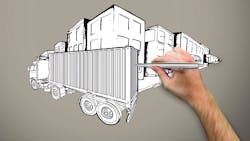Branding Yourself: Slogans and more showcase who you are
How is your trucking company different from all the other small and micro-carriers? In simple terms, this is the basic premise of company branding. So how do you increase your trucking operation’s name recognition?
First, develop a slogan or motto and keep it under a dozen words; explain in one short sentence the goal of your company. Here are some examples of effective slogans:
- Advance Auto Parts: We’re Ready In Advance
- AGCO (manufacturer and distributor of agricultural equipment): A World of Solutions for Your Growing Needs
- Ford Motor: Built for the Road Ahead
- Harley-Davidson: Define Your World In a Whole New Way
- Midwest Hauling: You Call, We Haul
Each one of these slogans defines the goals and business intentions of these companies. To be a successful part of a company’s branding, a slogan needs to be memorable, clever and catchy, and it needs to define what you do in as few words as possible. But be very careful that it doesn’t send the wrong message.
As an example, there was a trucking company with a logo of a camel on its trucks, and its motto was ‘We Hump To Please.’ When the motto was seen in conjunction with the logo, it sent a message of a desert caravan with camels as the beasts of burden hauling freight. But by itself, however, the motto potentially had another message—and in street slang at that.
Develop a mission statement that states the purpose of your company, why your company exists, and the value you provide to your shippers, brokers, other customers, vendors as well as your drivers. Incorporate your motto or slogan into the statement—something memorable, easily repeated by your employees, and said in less time than it takes to ride an elevator for a couple of floors.
The components of a mission statement should be as follows:
Who – Define your organization.
What – To what is your organization dedicated?
How – How do you meet quality, cost, time and service requirements?
Where – Where are you based and where do you operate from?
Why – Why does someone benefit from what you do?
Some examples include:
WalMart (founding)—To give ordinary folk the chance to buy the same thing as rich people.
WalMart (1990)—Become a $125 billion company by the year 2000.
Otis Lift Co.—To rise unnoticed.
Boeing—To push the leading edge of aviation, taking huge challenges doing what others cannot.
Boeing (1950s)—Become the dominant player in commercial aircraft and bring the world into the jet age.
In these examples, the mission statements of WalMart and Boeing changed as both the culture and company direction changed, so neither a company’s mission statement nor slogan is set in stone. In branding, it’s important that these reflect the goals and mission of your company as it began and as it is now.
Select a company name that reflects your slogan and mission statement. Again, think simplicity and a name easy to remember. When a person hears or reads your trucking company name, it should bring to mind what your company specializes in and what you do. Involve the idea of quality and appeal to your customer/shipper base.
As an example, if you’re a livestock hauler, tradition says you use the name of the ranch, farm or the last name of the trucking company owner. Unless you’re trying to buck tradition, it’s probably best to continue with that tradition. But maybe you specialize in hauling potatoes or onions.
I knew a carrier named Ankle Pik, reflecting the fact it hauls produce that’s harvested at ankle level. Another carrier is named Xtreme Trucking, and it specializes in over-dimensional freight. Both have memorable names, ones I’m sure many of you will remember long after reading this article.
Design a logo that reflects your slogan, mission statement, and company name. If your logo looks amateurish, then so will your trucking company. Be willing to engage a qualified graphic artist to design your logo. Provide him/her with your slogan, mission statement, and company name from which to develop several logo designs. Choose the one that best meets all of the criteria. For the first go-round, let the graphic artist have free rein in the design. Then work to come up with the one that best fits your company.
The company logo will be on the sides of your trucks, drivers’ and office staff shirts and caps, plus business cards, letterhead, invoices, brochures and advertising. So, it must be simple and be easily identifiable from a distance as well as close up. Think Coke, Nike, Apple, Canon, General Electric, and McDonald’s.
Once you have the above components in place, send out an email with the logo and slogan included. Your company logo and slogan should be on every invoice or statement mailed or emailed as well as on every truck, business card, post card, brochure or correspondence sent from your trucking company.
And it needs to be on your website, company Facebook, Twitter and LinkedIn pages. Every employee and contractor must memorize the company’s mission statement. When someone asks them what your trucking company does, they can begin the conversation by quoting your mission statement.
You must maintain the high level of quality and service that your slogan and mission statement imply. Then your logo, trucks and employees will have the brand recognition you’re seeking. When someone familiar with your company sees your logo, they’ll immediately identify “quality and customer service” as being who you are.
